|
What are Shanties?
Shanties are tuneful, rousing songs with a pronounced beat, sung by sailors at their work. Although records show the earliest shanties as being well over 200 years old ('Lowlands' was sung on Sir Walter Raleigh's ship), the most creative time for shanty singing was between 1820 and 1850.
Shanties fall into separate categories, differing in rhythm and timing: some long and repetitive for capstan-hauling, others having a short, jerky delivery for hand-over-hand-hauling or pumping, while others incorporate action words which were shouted for the 'stamp-and-go' long-hauling.
Hand in hand with the shanty is another type of sea-song, the forebitter. It is a simple sea-song or a ballad with a nautical flavour, sung for entertainment during the off-watch. On warm tropical nights the sing along would take place on deck around the forebits, hence the name.
The selection of a shanty to accompany a particular task, and the leading of the singing, was primarily the duty of the shantyman. He would sing the verse and stamp or beat the rhythm, while the crew joined in boisterously rather than tunefully in singing the choruses and heaving and hauling on the shouted words. |
|
|
Evolution of Shanties
The nineteenth century was probably the most popular period for shanty singing, for great fleets of sailing ships pursued their business in this their heyday before steamships began to take over.
The major happenings of the time proved the inspiration of many of the shanties. The French wars gave rise to 'Boney Was a Warrior' and 'Blood Red Roses'. From the American Civil War came 'The Alabama', and Britain's Jack Tar quickly put his own words to 'Marching Through Georgia', 'John Brown's Body' and 'When Johnny Comes Marching Home Again'.
The 1820s until the 1850s, including the period of the Irish Potato Famine and the great migration to America by the Irish, saw the introduction of the Western Ocean Packets (Black Ball Line and the Blue Cross Line recurs in a number of songs).
The emigrants and the Packet Rats were responsible for a whole range of new songs, such as 'Liverpool Judies', 'The Liverpool Packet', 'The Banks of Newfoundland', 'Paddy West', 'Paddy Doyle's Boots', 'Paddy Lay Back', 'Leave Her, Johnny', 'Blow the Man Down' and 'Can't You Dance the Polka'.
A further important period was the growth of the cotton trade around the confluence of the Mississippi, the Ohio and Missouri rivers and Mobile Bay. It was here that the sailors developed the new skill of cotton 'Hoosiers', down in the holds of their own ships. There they worked side by side with the Negroes stowing bales of cotton, known as 'Screwing Cotton', by forcing the bales into every corner.
Popular songs among the sailors at that time were 'Donkey Riding', 'Shenandoah', 'Johnny Come Down to Hilo' and 'Clear the Track, Let the Bulgine Run' which demonstrates the coexistence of black and white sailors.
1848 saw the west coast of America opened up by the finding of gold in Sacramento, California. No Panama Canal existed then and everyone had to go by way of the dreaded Horn. Soon new shanties were being sung, telling of the hardships suffered in the tempestuous Southern Ocean and the Roaring Forties - shanties like 'Valparaiso Round the Horn', 'Sacramento', 'The Gals around Cape Horn' and 'Good-bye Fare-ye-well'.
Australia produced it's own smaller crop of shanties due to it's own gold rush and the wool-clippermen (flying-fish sailors), the most famous of which is the capstan shanty 'South Australia'. Another famous shanty 'Strike the Bell' pinched the tune from a sheep farmers song called 'Click Go the Shears'.
The opening of the Suez Canal in 1867 saw the 'damnable tin-kettles' (steamships) taking over the China tea and the Australian wool trades. So sadly the great sailing ship era died, and with it faded the necessity to create new shanties.
Shanties can be said to be one of the earliest and truest examples of folk music, setting out simply and tunefully the hopes and aspirations of their creators, describing the important events of the times and leaving a melancholy record of the hardships endured by simple sailormen and their dependents in an illustrious period in Britain's maritime history. |
|
|
Types of Shanties
There are two main kinds of shanties. First are the work shanties that are divided into short drag (short haul), long drag (halyard), windlass, and capstan songs. Second are the forecastle or fo'c'sle shanties. These are often ballads or tell of some historical event, and take their name from the part of the ship where the singing usually took place, the forecastle, which was the crew's quarters.
Short drag or short haul shanties were for tasks that required quick pulls over a relatively short time, such as shortening or unfurling sails. When working in rough weather these songs kept the sailors in a rhythm that got the job done safely and efficiently.
Long drag or halyard shanties were for work that required more setup time between pulls. It was used for heavy labour that went on for a long time, for example, raising or lowering a heavy sail. This type of shanty gave the sailors a rest in between the hauls, a chance to get a breath and a better grip, and coordinated their efforts to make the most of the group’s strength for the next pull. This type of shanty usually has a chorus at the end of each line.
Capstan (or windlass) shanties were used for long or repetitive tasks that simply need a sustained rhythm. Raising or lowering the anchor by winding up the heavy anchor chain was their prime use. This winding was done by walking round and round pushing at the capstan bars, a long and continuous effort. These are the most developed of the work shanties.
Pumping Shanties. Pumps were fitted in ships to empty the bilge (the lowest part of the ship) of water. Wooden ships leaked, but not so fast that the crew could not pump the water out. There were several different types of pumps, which accounts for the variation in the timing of pumping shanties.
Forebitter or Forecastle Shanties. In the evening, when the work was done, it was time to relax. Singing was a favored method of entertainment. These songs came from places visited, reminding the sailors of home or foreign lands. Naturally the sailors loved to sing songs of love, adventure, pathos, famous men, and battles. Of course after all the hard work just plain funny songs topped their list.
Whaling Shanties. Life on a whaler was worse than on any other type of vessel; your life might be shorter on a pirate’s ship, but the work wouldn't be so hard! Voyages typically lasted from two to three years, and sailor’s lives were filled with unrelenting, dangerous work and the ever-present stench of whale oil. Whalers risked maiming and death when giving chase in small boats that were often overturned or even smashed by the whale’s tail in the fight! Songs helped give these men the will to go on in the face of their dreadful circumstances.
Pilot verses were sailing directions sung to popular tunes. This was a handy way to memorise crucial navigation information. There's a bunch of Newfoundland ones recorded in the Admiralty Court, in London. Hugill quotes one from this collection, dated 1756, which was apparently considered the best guide to Newfoundland waters at the time. It's to the tune of "I'll Tell me Ma", which is still well known.
From Bonavista to the Cabot Isles
the course is north full forty miles
When you must steer away nor'-east
till Cape Freals, Gull Isle, bears west-nor'-west
Then nor'-nor'-west thirty-three miles
three leagues off shore lies Wadham's Isles,
Where of a rock you must beware
two miles sou'-sou'-east from off Isle bears. |
|
|
The Origin of the word Shanty
The exact origin of the word 'shanty' is lost in the mists of time, but a number of theories have been put forward, any of which may be correct.
1. French "chantez" - either Norman French, Modern or 'Gumbo' dialect of New Orleans.
2. English "chant" or Old English "chaunt"
3. The drinking Shanties (bars) of the Gulf of Mexico ports (Mobile in particular) where black and white would congregate. Despite the non "musical" origin of the word, many coloured sailors went to sea from this area during the C19th and made reputations as singers of work songs.
4. Much the same as 3. - in Australia a "shanty" is a public-house, especially an unlicensed one (1864) and to shanty is to carouse or get drunk. Again, during the C19th, many seagoing shanteymen came from Australia and few people are likely to deny that drinking and singing (and sailors!) often go together.
5. Boat songs of the old French voyageurs of the New World, known as chansons.
6. The lumbermen's songs which often start with "Come all ye brave shanty-boys" - a shantyman here being a lumberman or a backwoodsman. However, it must be noted that the derivation is given as from the French, via French-Canadian, "chantier" - a work site or workshop, and not from "chanter" - to sing. Therefore the connection "workshop/lumberman" to "deep sea shipboard songs" seems quite tenuous.
7. West Indian Negroes used to move their shanties (huts built on stilts) by gangs pulling with a singing leader perched on the roof - he was the shanty man. |
|
|
Mollymawk
The mollymawks are a group of medium-sized albatrosses that form the genus Thalassarche. The word mollymawk, which dates to the late 17th century, comes from the Dutch mallemok, which means mal – foolish and mok – gull. |
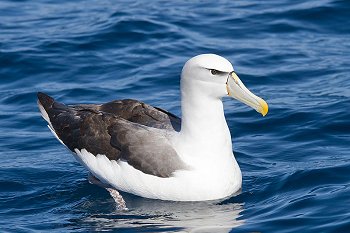 |
|
|
Kanaka
Kanaka, (Hawaiian: “Person,” or “Man”), in the late 19th and early 20th centuries, any of the South Pacific islanders employed in Queensland, Australia, on sugar plantations or cattle stations or as servants in towns. "Kanaka", originally referred only to native Hawaiians, from their own name for themselves, kānaka ʻōiwior kānaka maoli, in the Hawaiʻian language. In the Americas in particular, native Hawaiians were the majority; but Kanakas in Australia were almost entirely Melanesian. In Australian English "kanaka" is now avoided outside of its historical context, as it has been used as an offensive term. |
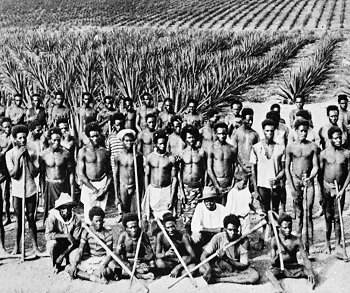 |
|
|
 |
|
|
Blow the man down
Between 1850 and the early 1900's, the fastest clipper ships were the Black Ballers, plying between Liverpool and New York. The westbound voyage was usually 4 weeks against the wind and the returning eastern voyage was about 3 weeks, going with the winds. And the more quickly a ship returned to homeport, the quicker a sailor would get paid. A position aboard the Black Ballers was one to be envied, however, the reputation of the Black Baller captains was notorious, they ran a brutal ship. When it was said that a man was blown down, it meant that he was beaten to the ground, which was rumored to happen often aboard the Black Ballers. |
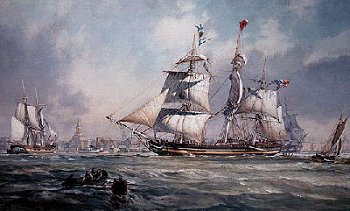 |
| 'Orpheus' of the Black Ball Line |
|
|
Bulgine
Clear away the track (Let the Bulgine Run). According to Hugill, "Bulgine" in the title of this old shanty was an American slang term for a railway engine. In this instance it refers to the little locomotives that ran along the dock delivering cargo to and from ships. |
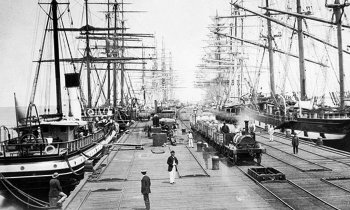 |
|
|
Dabtoes
Dabtoes forrard and the dustmen aft, is part of the chorus from "Chicken on a Raft" by Cyril Tawney. There are several definitions for this. The most likely being from Tom Lewis, in the Royal Navy "Seamen" were viewed as being light - or "dab" - on their toes.
Another definition states; dabtoes were deck sailors, who often got their feet wet, and the dustmen were stokers. Another version; Seamen, because they wore dabs (plimsoles). Yet another: Seamen that painted (dabed) the rusty bits. But, they all agree it's the lowly Seaman.
|
|
|
The Dead Horse
A ship would dock and the sailors go on shore where they would spend all their wages long before it was time for the ship to leave. This was somewhat depressing, since most of the "attractions" of the port would not take credit...and so the custom of "drawing on a dead horse'', or drawing a month's wages in advance, came into being.
Unfortunately, this leads to an equally depressing payday a month later, where your shipmates are getting paid, and you aren't.
A ritual developed around the "death'' of the debt. The ship's sailmaker would use the materials at hand to build an effigy of a horse, and at dusk a solemn candlelight procession would form on deck. The horse would be paraded around the ship three times, and then hoisted on a rope to the topmost yardarm. There, the youngest member of the crew would cut the rope on cue, dropping the horse into the sea. The traditional three-cheer salute was given, and the captain would issue a ration of grog to each man |
|
|
Donkey Riding
A traditional work song or sea shanty originally sung in Canada, Scotland and the Northeastern United States. It has also become popular as a children's song.The earliest written record of the song dates to 1857.The tune and words are an adaptation of "Highland Laddie". It is generally, but not universally, agreed that the "donkey" of the song title is a reference to the steam donkey, a kind of general-purpose steam engine. |
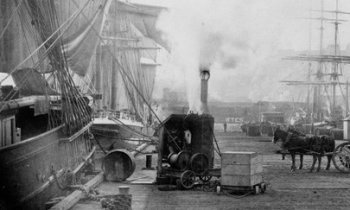 |
| Green Street Wharf in San Francisco during the 1880s with a donkey engine in use. |
|
|
General Taylor
General Zachary Taylor defeated the Mexican General Santa Ana at Buenavista in February 1847, helping to secure Texas, and gain California, for the United States. He became President of the USA after the war with Mexico, but died after only a short term in office. A.L. Lloyd thought that this shanty probably dates from around 1850, though many of the elements in it (the ritual funeral, the references to the semi-mythical "Stormy" or "Stormalong"), are older. |
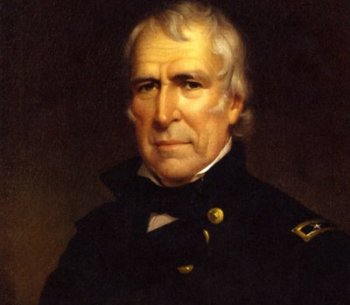 |
|
|
Horatio Nelson (1758 - 1805)
'England expects that every man will do his duty.' With these words Nelson successfully inspired his squadron before the Battle of Trafalgar, in 1805, during which he died. At his death, Britain lost a complex leader who balanced a personal longing for honour and glory with a compassion and respect for his men.
Born in Burnham Thorpe, Norfolk, the sixth of 11 children, he joined the Navy at age 12. He became a captain at age 20, and saw service in the West Indies, Baltic and Canada. He married Frances Nisbet in 1787 in Nevis, and returned to England with his bride to spend the next five years on half-pay, frustrated at not being at sea.
When Britain entered the French Revolutionary Wars in 1793, Nelson was given command of the Agamemnon. He served in the Mediterranean, helped capture Corsica and saw battle at Calvi (where he lost the sight in his right eye). He would later lose his right arm at the Battle of Santa Cruz de Tenerife (1797).
As a commander he was known for bold action, and the occasional disregard of orders from his seniors. This defiance brought him victories against the Spanish off Cape Vincent in 1797, and at the Battle of Copenhagen four years later, where he ignored orders to cease action by putting his telescope to his blind eye and claiming he couldn't see the signal.
At the Battle of the Nile (1798), he successfully destroyed Napoleon's fleet and bid for an overland trade route to India. His next posting took him to Naples, where he fell in love with Emma, Lady Hamilton. Although they remained married to others, they considered each other soul-mates and together had a child, Horatia, in 1801. Earlier that same year, Nelson was promoted to Vice-Admiral.
Over the period 1794 to 1805, under Nelson's leadership, the British Navy proved its supremacy over the French. His most famous engagement, at Cape Trafalgar, saved Britain from threat of invasion by Napoleon, but it would be his last. Struck by a French sniper's bullet he died on the first day of battle, October 21, 1805. |
 |
|
|
Mother Carey
Mother Carey is a supernatural figure personifying the cruel and threatening sea in the imagination of 18th- and 19th-century English-speaking sailors. She was a harbinger of storms and a similar character to Davy Jones (who may be her husband). |
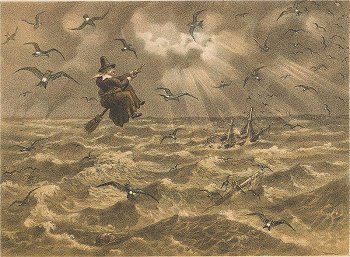
Mother Carey and her chickens by J G Keulemans 1877 |
|
|
Stormalong
Captain Alfred Bulltop Stormalong was an American folk hero and the subject of numerous nautical-themed tall tales originating in Massachusetts. Stormalong was said to be a sailor and a giant, some 30 feet (9.1 m) tall; he was the master of a huge clipper ship known in various sources as either the Courser or the Tuscarora, a ship purportedly so tall that it had hinged masts to avoid catching on the Moon. The name of Stormalong first appeared in a cycle of sea shanties that Stan Hugill, in his Sea Shanties of the Seven Seas, traces back to African-American folk songs of the 1830s and '40s. Bearing names like "Mister Stormalong", "Way Stormalong John", and "Yankee John, Stormalong", these sailors' work songs generally featured praise for a deceased seaman. |
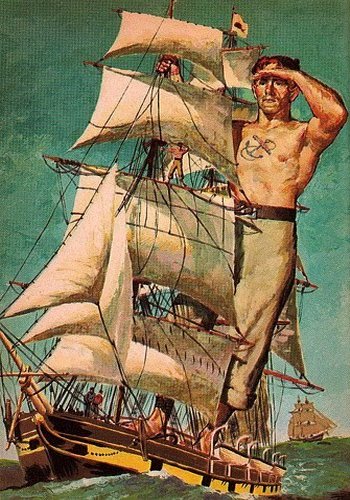 |
|
|
 |
|
|
|
|
The Story of Grog
|
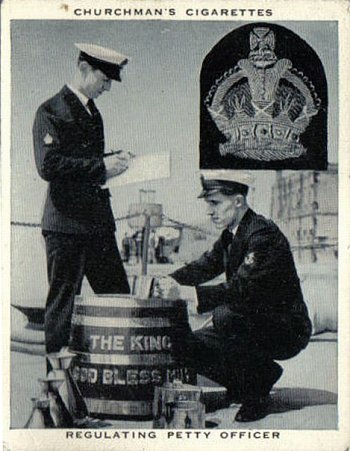 |
From the earliest days of sail, men needed liquid during voyages. Water quickly developed algae and turned slimy, and beer turned sour. The original ration of beer for seamen was a gallon a day, a significant amount to store over a long voyage. As the British Empire grew and longer voyages became more common, the problem of spoilage and shortages increased.
The origin of grog lies with Vice-Admiral William Penn, father of the founder of Pennsylvania. In 1655, during Penn's campaign for Cromwell in the Indies, Penn arrived in Barbados and captured Jamaica. Unfortunately Jamaica had few stores of beer or wine. Jamaica did, however, have rum. Penn, therefore, began the use of rum as a ration.
In the seventeenth century, an early form of rum was known as "rumbustion." In Elizabeth I's time, privateers and pirates traded in rum, and it was a liquor well-known to sailors. After 1655, as the Indies became an increasingly popular port, the use of rum increased. Although it became common, rum was not part of the "Regulations and Instructions Relating to His Majesty's Service at Sea" until 1731 at which time a half a pint of rum was made equal to the provision of a gallon of beer. In the early days this was specific only to ships in the West Indies, and rum was not diluted.
Vice-Admiral Edward Vernon is known as the father of grog. Vernon was a noted seaman, and victorious at Porto Bello. He was also a constant critic of the Admiralty and a supporter of better conditions aboard ships. He derided pressment and advocated better treatment of sailors. His sailors gave him the name of "Old Grog" because of a waterproof boat cloak he wore. The boat cloak was made of grogam, a thick material which was a combination of silk, mohair and wool. Grogam was often stiffened with gum.
By Vernon's time straight rum was commonly issued to sailors aboard ship - and drunkenness and lack of discipline were common problems. On August 21, 1740, Vernon issued an order that rum would thereafter be mixed with water. A quart of water was mixed with a half-pint of rum on deck and in the presence of the Lieutenant of the Watch. Sailors were given two servings a day; one between 10 and 12 AM and the other between 4 and 6 PM. To make it more palatable it was suggested sugar and lime be added. In 1756 the mixture of water and rum became part of the regulations, and the call to "Up Spirits" sounded aboard Royal Navy ships for more than two centuries thereafter. |
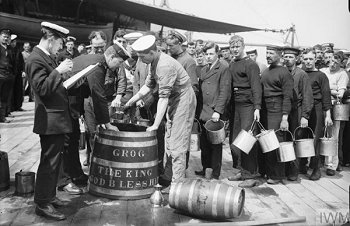 |
If the use of grog was common practice, the mixture was anything but standard. Vernon ordered a quarter of water to a half a pint of rum (four to one), others ordered three to one, and Admiral Keith later issued grog at five to one. The mixture seamen used for grog was named by compass points. Due North was pure rum and due West water alone. WNW would therefore be one third rum and two thirds water, NW half and half, etc. If a seaman had two "nor-westers," he'd had two glasses of half rum and half water.
Rum aquired the nickname "Nelson's Blood" after Trafalgar (1805). Legend has it that Lord Nelson's body was placed in a barrel of rum for preservation, when the sailor's learned of this, they drank the rum. From that time on, grog was also known as "Nelson's Blood". (In fact it was a barrel of brandy.)
Dilution of rum into grog did not solve the problem of lack of discipline. In 1823 the Admiralty conducted an experiment cutting the daily rum ration in half, to one quarter pint (gill). In compensation they issued tea and cocoa, increased pay two shillings a month. In 1824 the experiment became permanent with the added bonus of an increased meat ration. However, as a gill at that time was equal to four double whiskies today, it was still a very strong mix. |
|
|
Screwing Cotton
An important period was the growth of the cotton trade around the confluence of the Mississippi, the Ohio and Missouri rivers and Mobile Bay. It was here that the sailors developed the new skill of cotton 'Hoosiers', down in the holds of their own ships. There they worked side by side with the Negroes stowing bales of cotton, known as 'Screwing Cotton', by forcing the bales into every corner.
|
 |
|
|
White Stocking Day
Seafarers families had to cope with the absence of their main wage earner for long periods of time. The sea shanty Rio Grande sings of White Stocking Day, which was when sailors’ female relatives dressed up in their best clothes, including white stockings, to go and collect their allotments of money from the various Liverpool shipping companies’ offices. In the early 20th century the politician Eleanor Rathbone of Liverpool criticised the traditional system of paying seamen because of the effect which it had on seamen’s families. Not all sailors made an allotment to their wives from their pay but only drew an advance note for themselves. Rathbone believed that wives should automatically receive a share of their husbands’ pay to ensure that their families were cared for. |
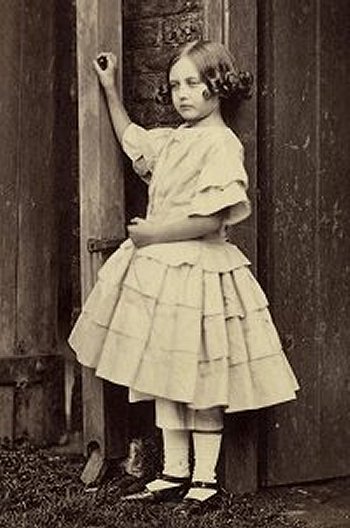 |
|
|
Sally Brown
Sally Brown, she’s a bright mulatto,
Way, hey, a-roll and go!
She drinks rum and chews tobacco
Spend my money on Sally Brown!
Oh, Sally Brown of New York City
That girl is just too Goddamn pretty
For many years I courted Sally
So did every Tom and Dick and Harry
I bought her silks, all frills and lacy
But they bought her drinks, that fickle lady.
I made a vow she’d be my missus
But she walked with them and gave them kisses
One morning bright I took a notion
To sail my ass across the ocean
Fourteen months I hauled the mainsheet
Then I found myself back down on South Street
I heard my name just by the mailer
She begged, “Come back, my tarry sailor.”
That Sally Brown of New York City
That girl is just too Goddamn pretty
Even though she has her own shanty and appears in many others, if you search for that beautiful creole lady called Sally Brown on the interweb, all you will find is Charley Brown's irritating little sister. |
 |
|
|
 |
|